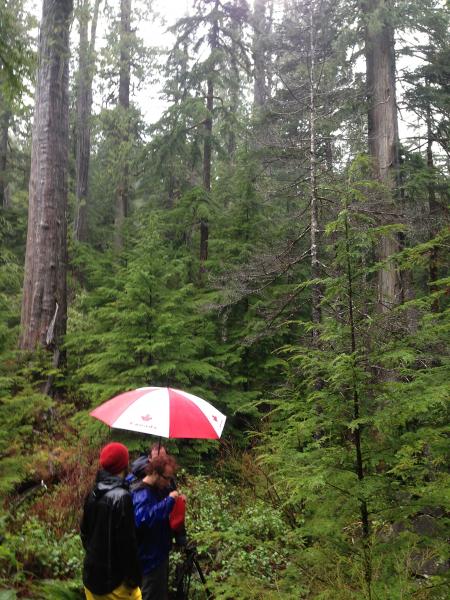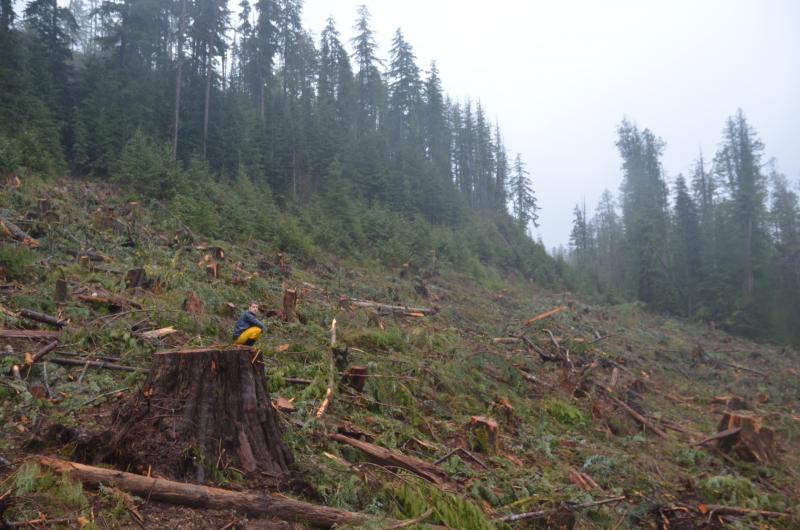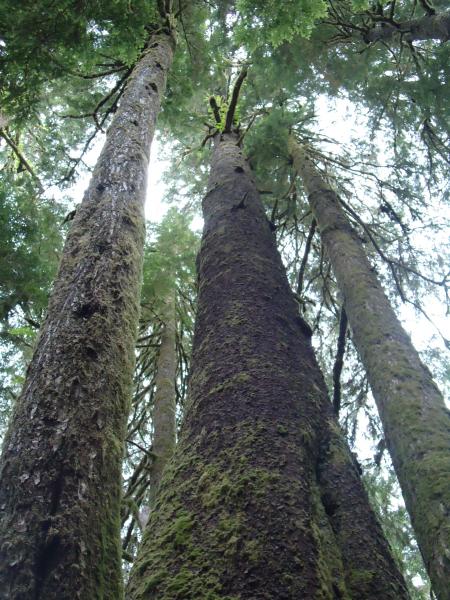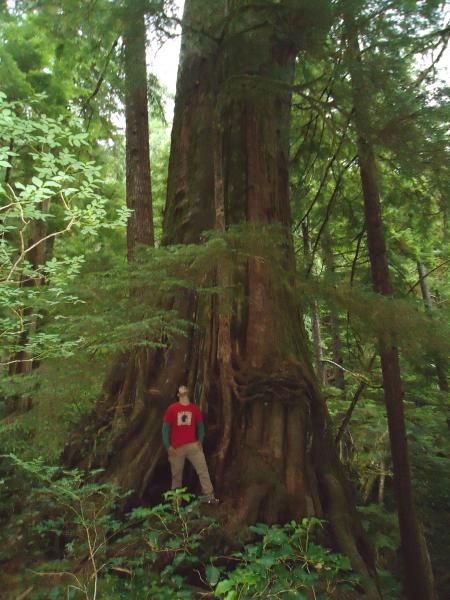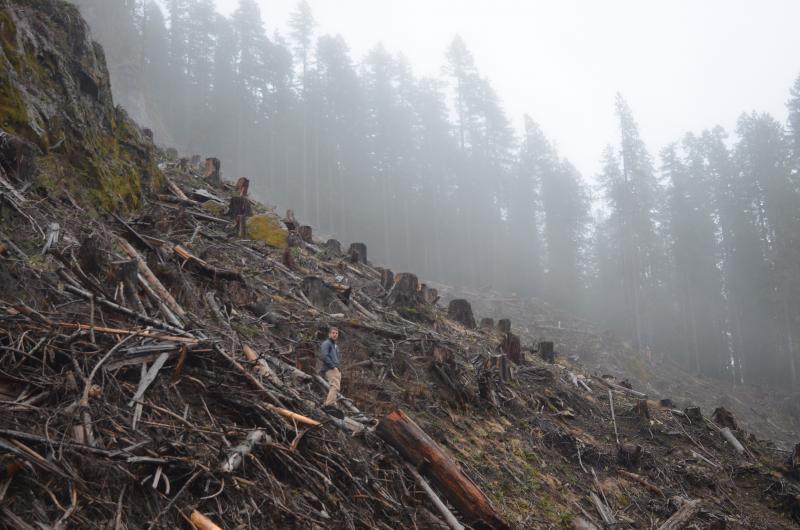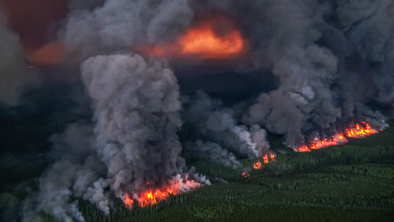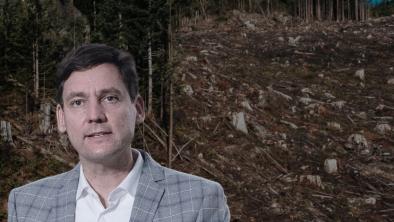Contrasts in the Walbran Valley and the need for forest policy reform in BC
Vancouver Observer
By Torrance Coste
April 18, 2013
“I don’t think I’ve ever been this wet and happy.”
These words, spoken by a young student-filmmaker from New York, are easily understood by any who’ve spent an afternoon downpour in the coastal temperate rainforest. Soaked to your skin and covered in mud, yet with a smile on your face – this feeling comes only in the presence of the world’s biggest trees.
Like all trips to the remnant patches of old-growth on Vancouver Island, my March 13th visit to the unprotected Upper Walbran Valley was at once inspirational and humbling.
Accompanied by a Wilderness Committee volunteer, I brought Jacob Wise and Adam Monzella, film students at Ithaca College, into the Walbran to shoot footage for a documentary they are making on the west coast’s ancient forests.
After their interest was sparked in a lecture on the temperate rainforest, Wise and Monzella began researching, planning, and saving up for a trip to Vancouver Island. They wanted to capture what’s left of the old-growth and learn why these ecosystems are almost gone; how a resource once so abundant could be mismanaged to the brink of extinction. Mainly, they wanted to see the forests for themselves.
I was keen to help them – I have a soft spot for anyone willing to cross a continent to get out in the woods, and highlighting old-growth and its importance is a key priority for the Wilderness Committee. I chose to take them to the Walbran Valley’s renowned Castle Grove. Recognized as one of the best old-growth red cedar stands in the world, yet still unprotected, it was vital that the Castle Grove be part of Wise and Monzella’s project.
We met in Lake Cowichan, a former boom town now feeling the effects of forestry decline, and set out on the white-knuckle ride into the Walbran. The drive takes two hours in good weather – which we definitely did not have. Leaving the truck for two minutes at a time to clear rock-falls from the logging road left us drenched and cold.
Then, just minutes from the trailhead into the Castle Grove, the real chill set in. We drove into a new clearcut where, on my last visit to the Walbran six months ago, a bona fide old-growth grove had stood.
The quiet desolation and overwhelming sense of loss you feel in an old-growth clearcut is difficult to describe. Wise and Monzella had seen pictures and read about this – it was a major motivator for their project. But being out amongst the shattered branches, torn and trampled undergrowth, and stumps that wouldn’t fit in their living rooms, left them speechless. After a few minutes, I gently reminded them that they might want to get some shots for their film.
Veteran volunteer Dave Manning, normally all smiles and laughs through his thick beard, climbed over the stumps in sullen silence, surveying the destruction with watery eyes.
When they had the footage they needed we moved down into the Castle Grove – to the standing forest. Crossing the bridge over the Walbran River and into the old-growth, we immediately felt our spirits lift, despite the torrential rain.
Entering the rainforest you really are going back in time – dwarfed not only by the trees but by undergrowth species like salal and huckleberry. Usually only a few feet tall in urban gardens, second-growth forests, and even some parks, these plants reach their true potential here, towering overhead several meters from the forest floor.
Then there are the trees. Because everything is so large, it takes your eyes a minute to adjust, but then you realize: that tree is three metres thick, sixty metres tall.
The trail into the Castle Grove is sketchy at best, and we made our way over slick logs and flash-streams that appeared before our eyes in the downpour. While these small streams and channels were plentiful, the sound of the Walbran Falls soon drowned out all other sound.
The falls, a peaceful and picturesque swimming spot in summer months, were now a rain-fuelled torrent that made the river uncrossable.
The heart of the Castle Grove is accessed by crossing the river on fallen logs or wading through shallow pools, just above or just below the falls. With the river like this, the best of the unprotected Walbran Valley – including the Castle Giant, one of the largest known cedars in Canada – was inaccessible to us.
Fortunately, you can’t really go wrong this close to the Walbran Falls; all the old-growth is incredible, and Wise and Monzella got some of the best shots of their trip.
After a few hours of great footage and ear-to-ear grins, the pair asked me if the clearcut we found on the way in was ever like this. I nodded, yes.
“It would’ve all been like this, at one time,” said Manning.
Wise and Monzella thought about this as they looked around, contrasting the jungle we were standing in with the desolation a kilometre or so up the hill. They were thinking back to other clearcuts on the way to the Walbran – in some stretches, it feels like you’re driving over the face of the moon.
This is the reality of the logging industry on southern Vancouver Island and the west coast. It isn’t forestry; it’s a race to the bottom. The forests are liquidated and re-liquidated, the trees that grow back are smaller and of poorer quality, and now half the logging trucks on the road carry tiny stems that are as thick as your arm and useless for much else besides pulp.
Near urban areas, the land is often not replanted, and in shocking instances of corporate welfare, the international logging giants that control the forests are granted rights by the provincial government to re-zone and sell land as real estate. This practice, known as log and flog, is one of the most scandalous forms of land-use in the province. The only winners are large corporations and the losers are the environment and the people of BC.
Out in the Walbran, where the land is less profitable as real estate, many clearcuts are still not replanted and the stumps and waste wood bleach white like terrible forest graveyards.
The only profit now is in the few remnant old-growth patches, so that’s where they’re cutting.
Most of the east side of Vancouver Island is private land, given to industrial developers in the 1800’s and sold to logging corporations thereafter. The management of these forest lands is technically regulated, but not well. Very little old-growth remains, and some high-value ecosystems like the Coastal Douglas-fir are almost extinct.
British Columbia is in dire need of forest policy reform – this is clear. It was something I was planning to address when Wise and Monzella interviewed me for their film. The old-growth clearcut we found in the Walbran made the point for me.
After decades of reckless forest management, more than 90 per cent of Vancouver Island’s productive old-growth has been cut – but it’s not completely gone. Nor has the potential for a sustainable value-added forest industry been totally erased. There is the knowledge and desire on this coast to make forestry work again for British Columbians and for our environment. The only thing needed is the political will.
For me, the standing old-growth represents not only some of the rarest and most productive ecosystems on Earth; they represent the future of forestry in BC. If we can’t protect the last few patches that exist, then our forest policy will go down in history as unsophisticated and weak, right until the end. Old-growth forests are now far more valuable standing than they are as timber, in terms of carbon sequestration, habitat conservation, and recreational opportunity.[AS1]
The Wilderness Committee is calling for a total ban on old-growth logging, effective immediately.
Next, we need to make forestry sustainable, both economically and environmentally. To do this, we must reprioritize who benefits from the industry. Currently, our forests are controlled by industrial giants. With offices as far away as Toronto and New York, these corporations care about shareholder profit first, with environmental and community well-being existing only as afterthoughts.
More sustainable and environmentally responsible policy will only come from those who actually need the forests to be sustained and the ecosystems to be resilient: the local people who depend on them. Rural communities – especially First Nations, who’ve been historically excluded from forest policy decisions on their own territories – need to be given more power in this process
More priority must also be given to secondary and tertiary production within BC. This means an immediate end to raw-log exports and a shift to a value-added forest industry. Other jurisdictions (Oregon, Sweden, Switzerland, etc.) have far more jobs per thousand cubic metres of timber than we do here in BC, and as a result, employ more people while cutting less wood.
Ending the liquidation of raw logs and recognizing the true value of our forests will provide more time to heal watersheds – a significant investment in our economic future and a critical step in taking pressure off the last patches of old-growth.
The call for forest policy reform isn’t new in BC. But frankly, time is running out. We can make this shift now and prioritize community and environmental well-being over corporate profits to create a more responsible forest economy. Or we can watch the industry roll on as it has for decades, liquidating the old-growth, decreasing growth periods on second-growth clearcuts, and lobbying government to allow corporations to clear and sell their land – basically working its way to the end of forestry on this coast.
On the ride back to Lake Cowichan, Wise and Monzella asked me if the disappearance of the forest industry was a real possibility. I explained that in some places it’s already a reality. In other places, like Lake Cowichan, it still exists, but as an unrecognizable shade of its former self. I told them one of the reasons I do what I do is because I believe the end of BC’s old-growth is something that could feasibly happen in the next decade or so.
Most agree that the forest industry will change drastically in the next decade – it is the direction of this shift that we need to decide on. The result of that decision will be our legacy to future generations.
